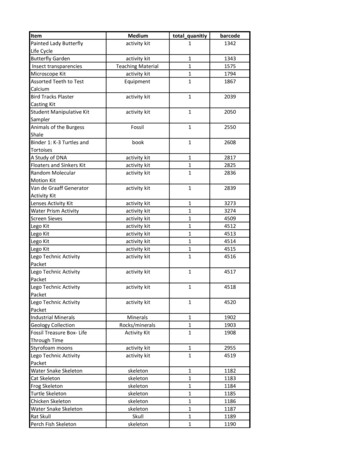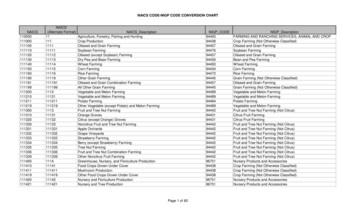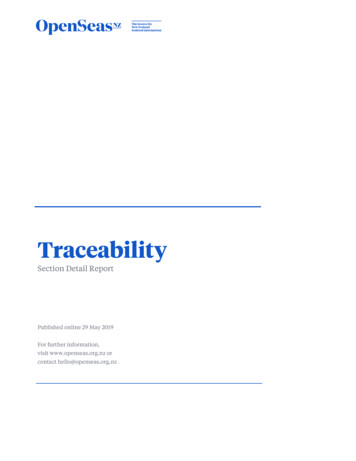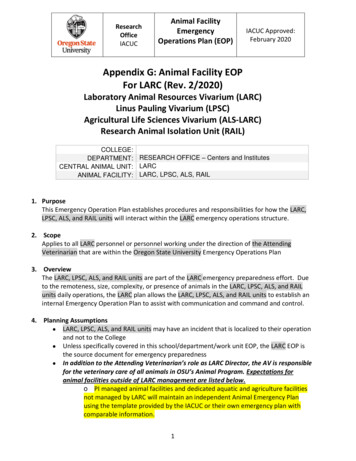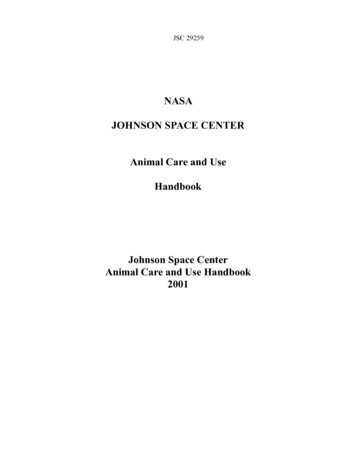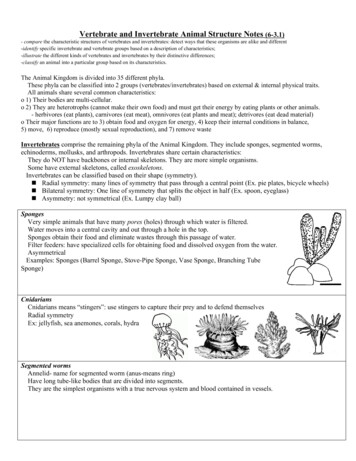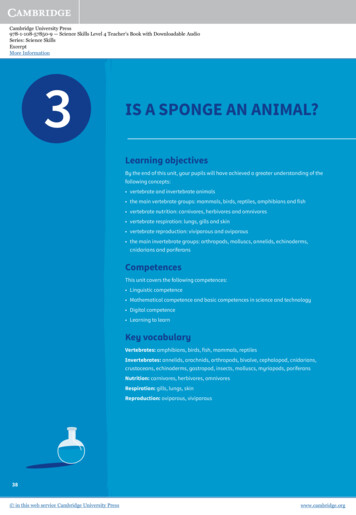
Transcription
Cambridge University Press978-1-108-57850-9 — Science Skills Level 4 Teacher's Book with Downloadable AudioSeries: Science SkillsExcerptMore Information3IS A SPONGE AN ANIMAL?Learning objectivesBy the end of this unit, your pupils will have achieved a greater understanding of thefollowing concepts: vertebrate and invertebrate animals the main vertebrate groups: mammals, birds, reptiles, amphibians and fish vertebrate nutrition: carnivores, herbivores and omnivores vertebrate respiration: lungs, gills and skin vertebrate reproduction: viviparous and oviparous the main invertebrate groups: arthropods, molluscs, annelids, echinoderms,cnidarians and poriferansCompetencesThis unit covers the following competences: Linguistic competence Mathematical competence and basic competences in science and technology Digital competence Learning to learnKey vocabularyVertebrates: amphibians, birds, fish, mammals, reptilesInvertebrates: annelids, arachnids, arthropods, bivalve, cephalopod, cnidarians,crustaceans, echinoderms, gastropod, insects, molluscs, myriapods, poriferansNutrition: carnivores, herbivores, omnivoresRespiration: gills, lungs, skinReproduction: oviparous, viviparous38 in this web service Cambridge University Presswww.cambridge.org
Cambridge University Press978-1-108-57850-9 — Science Skills Level 4 Teacher's Book with Downloadable AudioSeries: Science SkillsExcerptMore InformationCambridge English Qualifications practiceYou will find A2 Flyers activity types in the following exercises:Pupil’s Book, Page 42, Activity 1 – Reading and Writing Part 6Activity Book, Page 19, Activity 12 – Reading and Writing Part 2Throughout this unit, you will find the following A2 Flyers vocabulary:after, air, also, as, beetle, begin, cut, decide, each, end, ever, find out, follow, for, front,fur, happen, if, important, information, insect, keep, large, ocean, octopus, other, planet,prepare, so, soft, thousand, together, tortoise, until, use, usually, will, wingMaterials needed for Hands on litmus paper test tubeMaterials needed for other activities pictures of vertebrate and invertebrate animals pictures of local bird species pictures of different beak types pictures of differently coloured beetlesInvestigateThe Investigate project that runs through this unit encourages pupilsto imagine they are wardens at a wildlife park, for which they have tomake signs with information about animals. The different Investigatestages practise the following skills: autonomous research decision-making communication presentation of workOther resources Interactive activities Flashcards: Animal kingdom Song: Mammals, amphibians, birds, fish and reptiles Video documentary: Marine invertebrates39 in this web service Cambridge University Presswww.cambridge.org
Cambridge University Press978-1-108-57850-9 — Science Skills Level 4 Teacher's Book with Downloadable AudioSeries: Science SkillsExcerptMore InformationUNIT 3PAGES 30–31Yes, sponges are animals. They belongto the poriferan group.Objective:Pupils will review vocabularyand concepts relating tovertebrate and invertebrateanimals studied in previousyears.3IS A SPONGE AN ANIMAL?Key vocabularyamphibian, arachnid, bird,cnidarian, crab, crustacean, dove,echinoderm, fish, frog, gastropod,iguana, jellyfish, mammal,mollusc, panda, reptile, shark,snail, spider, sponge, starfishWarm up Play a game of odd one out toreview the different vertebrate andinvertebrate groups. Stick flashcardsof four different animals up on theboard or, alternatively, displayphotos of four different animalsusing the IWB. One of the fouranimals has to be the odd one out,for example: crocodile, frog, iguana,turtle – the frog is the odd one out.Once you have played a few roundsof the game, let volunteers choosethe four cards to display on theboard.ups?Can you identify the five vertebrate gro30Mammals, amphibians, birds, fish and reptiles40 in this web service Cambridge University Presswww.cambridge.org
Cambridge University Press978-1-108-57850-9 — Science Skills Level 4 Teacher's Book with Downloadable AudioSeries: Science SkillsExcerptMore InformationMain conceptsSponge, spider, crab, snail, starfish, jellyfish Ask pupils the questions about theimages. For the pictures on page30, encourage pupils to name theanimals as well as the vertebrategroups. For the pictures on page 31,ask pupils if they have ever seenthese animals in real life. Finally, read the intro text about theInvestigate project. Explain the roleof wardens in wildlife parks.Learn moreCan you identifyany of theseinvertebrates?Mammals, amphibians,birds, fish and reptilesCan you name thegroups they belong to? Use the photos on these pages toget pupils thinking about otherconcepts they will be working on inthis unit. Ask questions: Where doesa frog live? Is an iguana a herbivore?What is the difference between aninsect and an arachnid?TipTo get pupils motivated aboutthe Investigate project, showthem online videos of somedifferent wildlife parks.D CUMENTARYMarine invertebratesIn this unit, you will become wardens at a wildlife park and make signs’with information about vertebrates and invertebrates for the visitorscentre. To do this, you will: learn about the five groups of vertebrates.of understand the differences in how they perform the life processesnutrition, reproduction and respiration.ing be able to classify invertebrates into six different groups, dependon their characteristics.Poriferan, arthropod (arachnidand crustacean), echinoderm,mollusc (gastropod), cnidarianSongThe song is this unit focuses onthe life processes of nutrition,respiration and reproduction inthe different vertebrate groups.31DocumentaryThe documentary in this unitfocuses on invertebrate speciesthat live in the seas and oceans.For next lesson pictures ofvertebrate and invertebrate animals41 in this web service Cambridge University Presswww.cambridge.org
Cambridge University Press978-1-108-57850-9 — Science Skills Level 4 Teacher's Book with Downloadable AudioSeries: Science SkillsExcerptMore InformationUNIT 3PAGE 32Lots of different things, depending on whetherthey are carnivores, herbivores or omnivores.Objective:Pupils will review some keyconcepts related to animals:vertebrates and invertebrates;nutrition, respiration andreproduction.WHAT DO VERTEBRATES EAT?This year, we will take a close look at animals. But first,let’s revise some things you already know.Key vocabularycarnivore, gills, herbivore,invertebrate, lungs, omnivore,oviparous, skin, vertebrate,viviparousVertebrates and invertebratesNutritionAnimals can be classified into twodifferent groups depending onwhether they have a backbone:Animals are consumers. This meansthey eat other living things. Differentvertebrates perform the life process ofnutrition in different ways:Vertebrates havea backbone.Warm upInvertebratesdo not have abackbone. Remind pupils that they are animalsas well. Ask: What vertebrate groupdo you belong to? How do youbreathe? etc. After reading the first section, askpupils to stand up. Show them aselection of images of vertebrateand invertebrate animals. Tellthem to remain standing if they arevertebrates or sit down if they are not.Continue until only one pupil remains.Herbivores onlyeat plants.RespirationReproductionAll vertebrates need to take inoxygen and release carbon dioxideto live, but different vertebratesbreathe in different ways:Vertebrates reproduce sexually, but theyreproduce in different ways:Viviparous vertebrates give birth tolive young. The embryo develops insidethe female.Some breathe with lungs.Oviparous vertebrateslay eggs. The embryogrows outside themother’s body in an egg.Others breathethrough gills.Some evenbreathe throughtheir skin.Which animalsbreathe throughtheir skin?Find out how ovoviviparousanimals reproduce.Find a hatched egg hidden somewherein this unit.32Adult amphibiansLearn more Ask pupils to find out aboutovoviviparous animals at home.Carnivores only eat other animals.Omnivores eatboth plants andother animals.Main concepts Repeat the activity with theother three sections: nutrition,reproduction and respiration. Asthere are three options in two ofthe sections, pupils can raise theirhands for one of them.By the end of thislesson, you willknow where theembryo developsin oviparousanimals.They produce eggs inside their bodies,but then give birth to live young.Hidden hatched egg on page 39.42 in this web service Cambridge University Presswww.cambridge.org
Cambridge University Press978-1-108-57850-9 — Science Skills Level 4 Teacher's Book with Downloadable AudioSeries: Science SkillsExcerptMore InformationUNIT 3PAGE 33Meerkats are omnivores.They eat insects and plants.Objective:WHAT DO MEERKATS EAT?Let’s look at how mammals perform nutrition,respiration and reproduction.Pupils will gain a greaterunderstanding of how mammalsperform the life processesof nutrition, respiration andreproduction.By the end ofthis lesson,you will knowhow whalesbreathe.Key vocabularyNutritionchimpanzee, cow, fox, lungs,monotreme, otter, panda, pig,seal, sloth, viviparousMammals can be carnivores, herbivores or omnivores.CarnivoresHerbivoresOmnivoresWarm up Ask pupils to look at the animals inthe table and name them.RespirationReproductionAll mammals breathe using their lungs.For example, whales take in and expelair through their blowhole when theycome to the surface of the water.Almost all mammals areviviparous. Mammalsthat lay eggs arecalled monotremes.The platypus and theechidna are examplesof monotremes.blowholelungstrachea If pupils do not know the names,give them time at the beginningof the lesson to find out using adictionary or the internet.Main concepts Ask pupils to explain the differencebetween carnivores, herbivores andomnivores. Can they name anyother mammals that are carnivores,herbivores or omnivores?Respiration in whales is voluntary.They have to decide when they wantto come to the surface to breathe.STAGE 1 Choose a mammal and research it. Make a sign. Include this information on the sign: what it eats the mammal’s name some of its physical where and how it was borncharacteristics the species33The stages of this Investigate project are best carried outat home. Before they get started, give pupils some tips ondoing online research, as well as the addresses of someage-appropriate websites where they can find informationon animals. Pupils can work in groups of five to complete thisproject. To make the task less time-consuming, each groupmember can find out one of the five pieces of information. in this web service Cambridge University Press After reading the section onrespiration, display the diagramof the whale on the IWB and invitea volunteer to come to the boardand explain how whales performrespiration.Learn moreFor next lesson photos of beak typesand local bird species Ask pupils to find out the names offive other aquatic mammals.43www.cambridge.org
Cambridge University Press978-1-108-57850-9 — Science Skills Level 4 Teacher's Book with Downloadable AudioSeries: Science SkillsExcerptMore InformationUNIT 3PAGE 34Fish and marine invertebrates.They will eat almost anything.Objective:Pupils will gain a greaterunderstanding of how birdsperform the life processesof nutrition, respiration andreproduction.By the end of thislesson, you willknow why birdshave differenttypes of beaks.WHAT DO SEAGULLS EAT?Let’s look at how birds perform nutrition, respirationand reproduction.Key vocabularyNutritionLike mammals, birds can be carnivores, herbivores or omnivores.We can tell what a bird eats by looking at its beak.Warm up Show pupils a video of how ahummingbird eats nectar from aflower, and discuss its beak.Main concepts After reading the text about nutrition,show images of different birds andask pupils to describe their beaks.Hawks have ahooked beak fortearing meat.Sparrows havecone-shaped beaks foreating seeds.Woodpeckers have long,strong beaks for peckinginto wood.Hummingbirds havelong, thin beaks foreating nectar.Toucans havelong, thick beaksfor eating fruit.Herons have long,pointed beaks forfishing and hunting.Respiration Read the section on respiration anddisplay the diagram of the bird onthe IWB. Invite a volunteer to explainhow birds perform respiration.lungsLike mammals,birds breathe usingtheir lungs. Unlikemammals, birdsdo not have atracheaair sacsdiaphragm. Instead,they use muscles in their chest andmuscles in their air sacs to inhaleand exhale.34Birds are oviparous. They lay eggswith hard shells. Most birds buildnests to protecttheir eggs frompredators and theweather. The adultbirds incubate1their eggs.to incubate: to sit on eggs to keep them warm and make them hatch Show pupils images of differenttypes of birds’ nests on the board,e.g. the nests of blackbirds, storks,etc. Ask them to guess what kinds ofbirds build nests like these.Reproduction1air sacs, beak, hawk, heron,hooked, hummingbird, peck,pointed, sparrow, tear, toucan,woodpeckerLearn more Ask pupils to observe and findinformation about birds in theirneighbourhood. They report back inthe next session.44 in this web service Cambridge University Presswww.cambridge.org
Cambridge University Press978-1-108-57850-9 — Science Skills Level 4 Teacher's Book with Downloadable AudioSeries: Science SkillsExcerptMore InformationUNIT 3PAGE 35Reptiles are oviparous.They lay eggs on land.Objective:Pupils will gain a greaterunderstanding of how reptilesperform the life processesof nutrition, respiration andreproduction.By the end ofthis lesson, youwill know howlong sea turtlescan hold theirbreath for.HOW DO REPTILES REPRODUCE?Let’s look at how reptiles perform nutrition,respiration and reproduction.Key vocabularyNutritionalligator, catch, crocodile,iguana, incubate, jaw, nurture,prey, reptile, sea turtle, tortoiseMost reptiles are carnivores, but someare omnivores or herbivores. Forexample, most iguanas and tortoisesare herbivores. Crocodiles and alligatorsare carnivores. They have long jaws1 forcatching their prey2 and sharp teeth for cutting up meat.Warm upRespirationReproduction Ask pupils if they know the namesof any reptiles that can be found intheir country.Like birds and mammals, all reptiles breatheusing their lungs. Even aquatic reptiles likesea turtles must come to the surface to inhaleair. However, sea turtles can hold their breathunder water for as long as seven hours if theyare resting.Like birds, reptiles are oviparous.They lay their eggs on land.However, unlike birds, reptiles donot incubate their eggs. They donot nurture3 their young either. Elicit personal experiences of pupilswith reptiles. Ask: Have you everseen a reptile in the wild? Has anyoneever held a snake? etc.lungsMain concepts Draw pupils’ attention to the photosin the section on nutrition. Ask whatanimals pupils can see and whatthey are eating. Then ask if they arecarnivores, herbivores or omnivores.tracheaSTAGE 2jaw: part of the mouth fromwhere the teeth grow;2prey: an animal that is huntedby another animal for food;3to nurture: to feed, take careand help to develop Choose one bird and one reptile. Prepare signs for each animal. For the bird, include a section on beak type. After reading the section onrespiration, using the class clockas a timer, ask pupils to hold theirbreath for as long as they can.135Learn moreAt this stage, the pupils find out the same information as in theprevious stage for a bird and for a reptile. They must also includea description of the type of beak the bird has and what they useit for, e.g. tearing meat, pecking into wood, etc. in this web service Cambridge University Press Draw a Venn diagram on the boardand ask pupils to compare howreptiles and mammals performnutrition, reproduction andrespiration.45www.cambridge.org
Cambridge University Press978-1-108-57850-9 — Science Skills Level 4 Teacher's Book with Downloadable AudioSeries: Science SkillsExcerptMore InformationUNIT 3PAGE 36Tadpoles breathe using gills. Adult amphibiansbreathe using lungs and their moist skin.Objective:Pupils will gain a greaterunderstanding of howamphibians perform thelife processes of nutrition,respiration and reproduction.They will also review the lifecycle of an amphibian.HOW DO AMPHIBIANS BREATHE?Let’s look at how amphibians perform nutrition, respirationand reproduction.Key vocabularyemerge, incubate,metamorphosis, sticky, tadpole,tip, transformationWarm upNutritionReproductionRespirationAlmost all adult amphibiansare carnivores. They preyon small invertebrates,such as beetles, caterpillars,worms and spiders.Many amphibians catchinvertebrates with their longtongues, which have a stickytip. Tadpoles are herbivores.Amphibians areoviparous. Theylay soft eggs inwater and do notincubate them. Afteremerging from theeggs, amphibiansexperience atransformation calledmetamorphosis.Amphibians change the waythey perform respiration.Before metamorphosis,they take in oxygen fromwater using their gills.After metamorphosis, theytake in oxygen from the airusing their lungs. Adultamphibians can also breathethrough their moist skin. Review some of the concepts relatedto amphibians that pupils havestudied in previous years.Can you remember the differentstages of metamorphosis?Describe them to a partnerusing the picture.lungsMain conceptsMETAMORPHOSISOxygenCarbondioxide After reading the main sections,check comprehension by showingpupils pictures of caterpillars, a longtongue with a sticky tip, etc. andasking them to find the words in thetext. The metamorphosis diagram hasintentionally been left unlabelled.Use the diagram to elicit thedifferent stages of metamorphosisfrom pupils.By the end ofthis lesson, youwill know howfrogs catchtheir prey.gills36Frogs lay eggs called frogspawn.Learn more Ask pupils to find out about themost colourful amphibian they canfind and print out a picture or do adrawing of it.Tadpoles hatch from the eggs.First, the tadpoles grow back legs.Next, they grow front legs.Finally, they lose their tail and move to the land.46 in this web service Cambridge University Presswww.cambridge.org
Cambridge University Press978-1-108-57850-9 — Science Skills Level 4 Teacher's Book with Downloadable AudioSeries: Science SkillsExcerptMore InformationUNIT 3PAGE 37Yes, fish sleep, but with their eyes open.Objective:Pupils will gain a greaterunderstanding of how fishperform the life processesof nutrition, respiration andreproduction.By the end of thislesson, you willknow how fishbreathe.DO FISH SLEEP?Let’s look at how fish perform nutrition,respiration and reproduction.NutritionReproductionThe majority of fish are carnivores.However, some fish like theparrotfish are herbivores. Others,like the catfish, are omnivores.Like amphibians,fish are oviparous.They lay their eggsunderwater and donot incubate them.Key vocabularycatfish, expel, filament, incubate,parrotfish, underwaterWarm up Review how mammals, birds,reptiles and amphibians performnutrition, reproduction andrespiration.Fish sleep with their eyes openbecause they do not have eyelids. Draw a table with five columns – onefor each vertebrate group. Ask pupilsquestions about the four groupsyou have just reviewed. If they get aquestion right, they come up to theboard and write the information inthe table.RespirationFish breathe through their gills.The fish takes in waterthrough its mouth. Thewater contains oxygen.The water passes through filamentsin the fish’s gills. These filamentsabsorb oxygen from the water andmove it into the blood.Main conceptsSTAGE 3 Choose one amphibian and one fish. Prepare signs for each animal.For the final two vertebrate groups, pupils searchfor the same information as in Stage 1. Encouragepupils to pick interesting amphibians and fish, forexample poison dart frogs and clownfish.Waste carbon dioxide isexpelled together with thewater through the gills.Fish have to constantlytake in fresh water tokeep breathing.37 After reading the sections onnutrition, reproduction andrespiration, ask volunteers tocomplete the column about fish inthe table you created in the Warmup activity. Then, ask pupils to copythe table in their notebooks.Learn more Show pupils a video of fish hatchingfrom eggs under a microscope.47 in this web service Cambridge University Presswww.cambridge.org
Cambridge University Press978-1-108-57850-9 — Science Skills Level 4 Teacher's Book with Downloadable AudioSeries: Science SkillsExcerptMore InformationUNIT 3PAGES 38–39No, not all insects have wings. For example,many ant species are unwinged.Objective:Pupils will further theirknowledge of three of the sixmain invertebrate groups:arthropods, molluscs andannelids. They will see fourarthropod subgroups (insects,arachnids, crustaceans andmyriapods) and three molluscsubgroups (gastropods, bivalvesand cephalopods).DO ALL INSECTS HAVE WINGS?About 97% of all animal species on the planet are invertebrates. Although there aremillions of different invertebrate species, we classify them into six main groups:arthropods, molluscs, annelids, echinoderms, cnidarians and poriferans.ArthropodsThis is the largest group of invertebrates. Arthropods have an exoskeleton, asegmented body and pairs of appendages¹. There are four main arthropod groups:Key vocabularyInsectsInsects have three main body sections:a head, a thorax and an abdomen.They have six legs and a pair ofantennae. Some insects have wings.Examples: butterflies, ants and bees.abdomen, annelid, antenna,arachnid, arthropod, bivalve,cephalopod, cephalothorax,claw, cnidarian, echinoderm,gastropod, insect, mollusc,myriapod, ring, sponge, thoraxabdomenthoraxArachnidsArachnids have two main body sections:an abdomen and a cephalothorax.They have eight legs. They do not haveantennae or wings, and can have asmany as eight eyes.Examples: spiders,scorpions and ticks.abdomenWarm upcephalothoraxCrustaceansMost crustaceans have two mainbody sections: an abdomen and acephalothorax. They have 10 legs.Their front pair of legs are sometimesclaws. They have two pairs of antennae.Examples: crabs and lobsters. Refresh pupils’ knowledge ofdifferent arthropod subgroups bygiving a dictation and asking pupilsto draw what you say. Here is anexample dictation for an insect: Thisarthropod has three body sections:a head, a thorax and an abdomen.It has two antennae. It has six legs.Finally, it has two wings. Writethe name of the group under yourpicture.MyriapodsMyriapods have two main sections:a head and a segmented body. Eachsegment of the body has one or twopairs of legs. They have one pair ofantennae. Examples: millipedes andcentipedes.body segmentabdomenantennaecephalothoraxlegsclaws38Try the observation activity on page 92. Itgives pupils the opportunity to observe moreclosely the characteristics of an arthropod.48 in this web service Cambridge University Presswww.cambridge.org
Cambridge University Press978-1-108-57850-9 — Science Skills Level 4 Teacher's Book with Downloadable AudioSeries: Science SkillsExcerptMore InformationMain conceptsHere’s the hidden hatched egg!Slugs do not have shells.MolluscsMolluscs are the second largest group of invertebrates.They have a soft body. Some molluscs live on land andothers live in the water. Almost all molluscs have a shell.They can be classified as follows:GastropodsThey have a largemuscular foot thathelps them move andmost have a shell.Snails and slugs aregastropods.Find out which gastropodsdo not have a shell.BivalvesThe shell of a bivalve is divided into twoparts, or valves. The soft body is insidethe valves. Clams and oysters are bivalves.Bivalves opentheir shell toeat, but closeit when theyare in danger. Before reading the section onarthropods on page 38, draw a tableon the board with four columns tobe filled in. On the left-hand side,write the following categories: bodysections; number of legs; antennae;wings. After reading each section,ask pupils questions about thearthropod group and ask volunteersto fill in the information in the table.When you have completed thetable, ask pupils to copy it into theirnotebooks.By the end ofthis lesson,you will knowhow many legsants have.CephalopodsCephalopods have an internalshell. They also havea prominent head.Instead of feet, theyhave tentacles.Octopuses, squidsand cuttlefish arecephalopods. Ask pupils to compare the fourgroups using the following structure:Insects have three body sections,whereas arachnids, myriapods andcrustaceans have two body sections.Repeat the process for the sectionon molluscs. Change the categoriesto: shell, feet, head and tentacles.AnnelidsThere are more than 17,000 speciesof annelids. Most live in water.Some, like the earthworm, live onland. Some annelids are parasitesand live inside other animals. Theirbody is long and soft, and madeup of rings. Earthworms andleeches are annelids.Learn more If you have a school garden or agreen area nearby, take pupilsoutside to look for annelids. Selecta small patch of land and dig up thesoil. Explain to pupils the importance ofearthworms to soil.STAGE 4Tip1appendage: an arm, leg Investigate and prepare a sign for one ofthe three invertebrate groups on these pages: annelids molluscs arthropods Include information on whether it is a marine orterrestrial invertebrate.39Assign different arthropod and mollusc subgroupsto different groups of pupils so there is variety in theanimals the pupils research. You can allow pupils tocome up with categories of information to research.To give pupils an idea of thevariety of invertebrate species,show them pictures of vividlycoloured beetles on the IWB.Clips from nature documentariesabout arthropods are easy tofind and really pique pupils’interest.49 in this web service Cambridge University Presswww.cambridge.org
Cambridge University Press978-1-108-57850-9 — Science Skills Level 4 Teacher's Book with Downloadable AudioSeries: Science SkillsExcerptMore InformationUNIT 3PAGE 40Sea cucumbers are aquaticinvertebrate animals, belongingto the echinoderm group.Objective:Pupils will become familiar withthe three remaining invertebrategroups: echinoderms, cnidariansand poriferans. The species inthese three invertebrate groupsall live in water.WHAT IS A SEA CUCUMBER?The animals in these three invertebrate groups all live in water.EchinodermsKey vocabularyEchino means ‘prickly’ andderm means ‘skin’. Mostechinoderms have a pricklystructure on the outside.They have an internalskeleton and tube feet,which help them attach tothings and move around.Starfish, urchins and seacucumbers are echinoderms.cnidarian, echinoderm, hydra,jellyfish, pore, poriferan, prey,prickly, sea anemone, seacucumber, sponge, starfish,tentacle, tube feet, urchin, venomWarm up Ask pupils if they have ever seenany animals at the seaside. Ask:Are there any animals that can hurtyou at the seaside? How? Elicit thatjellyfish can sting you and seaurchins can prick you with theirvenomous spines.By the endof this lesson,you will knowhow spongeseat.CnidariansCnidarians do not have a heador a brain, but they do have amouth! It is their only bodyopening. The mouth is usuallysurrounded by tentaclescontaining venom, whichthey use to catchtheir prey. Jellyfish,sea anemones, coraland hydras arecnidarians.PoriferansEchinoderms can regeneratebody parts if they lose themto a predator.Main concepts Ask three volunteers to read the mainsections. Draw pupils’ attention to theword poriferan. Why do you think thisgroup has this name? Lead them tounderstand the connection betweenthe words pore and poriferan.Poriferans live at the bottom of theocean. They attach themselves torocks and do not movearound. There are poreson their bodies, whichwater passes through.This is how they gettheir food. Spongesare poriferans.STAGE 5 Investigate and prepare a sign for one of the three invertebrate groups onthis page: poriferans cnidarians echinoderms40Learn more Brainstorm ideas with pupilsabout how we can stay safe fromvenomous echinoderms andcnidarians at the beach.Draw pupils’ attention to the examples of echinoderms and cnidarians on thispage: sea urchins, sea cucumbers, starfish, jellyfish, sea anemones and hydras.Ask them to choose from these options. They can also research informationabout how echinoderms and cnidarians use venom for hunting and self-defence.50 in this web service Cambridge University Presswww.cambridge.org
Cambridge University Press978-1-108-57850-9 — Science Skills Level 4 Teacher's Book with Downloadable AudioSeries: Science SkillsExcerptMore InformationThe litmus paper turned red.No, as the percentage of carbondioxide in the air is very low.UNIT 3PAGE 41Objective:Pupils will carry out a practicalinvestigation into vertebrateand invertebrate respiration.BREATHING OUTKey vocabularyBefore we startVertebrates and invertebrates inhaleoxygen and exhale carbon dioxide. Carbondioxide turns blue litmus paper red.blow, carbon dioxide, exhale,inhale, litmus paper, oxygen, testtubeMaterialsblue litmus paper, test tubeWarm upMethod1 Place the piece of litmus paper insidethe test tube.2 Blow into the test tube.3 Observe what happens to the litmuspaper.ConclusionsWhat happened to the litmus paper? Ask pupils to stand up and take adeep breath. Ask them what theyhave inhaled. Explain that as wellas oxygen in the air, there is alsocarbon dioxide. Tell pupils to runon the spot for 30 seconds, then askthem if there is now more oxygenin the air in the classroom thanbefore. Elicit that because they werebreathing more, there is now morecarbon dioxide in the air.Leave another piece oflitmus paper outside.Does anything happen to it?What does this show? Talk toyour partner.Can you think of anotherway to say ‘breathe out’that begins with ex-?Main conceptsDid you know that webreathe in about eight litresof air every minute?41This shows that when weexhale, we expel carbon dioxide.Exhale Pupils work in pairs to completethis investigation. Distribute thematerials to each pair. One pupilholds the test tube and the litmuspaper while the other pupil blowsinto the test tube. Read and discussthe first concl
snail, spider, sponge, starfish Warm up Play a game of odd one out to review the di erent vertebrate and invertebrate groups. Stick flashcards of four di erent animals up on the board or, alternatively, display photos of four di erent animals using the IWB. One of the four animals has to be the odd one out, for example: crocodile, frog, iguana,
